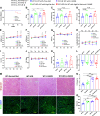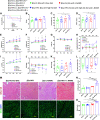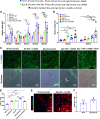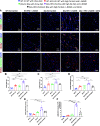Combining three independent pathological stressors induces a heart failure with preserved ejection fraction phenotype
- PMID: 36763506
- PMCID: PMC9988529
- DOI: 10.1152/ajpheart.00594.2022
Combining three independent pathological stressors induces a heart failure with preserved ejection fraction phenotype
Abstract
Heart failure (HF) with preserved ejection fraction (HFpEF) is defined as HF with an ejection fraction (EF) ≥ 50% and elevated cardiac diastolic filling pressures. The underlying causes of HFpEF are multifactorial and not well-defined. A transgenic mouse with low levels of cardiomyocyte (CM)-specific inducible Cavβ2a expression (β2a-Tg mice) showed increased cytosolic CM Ca2+, and modest levels of CM hypertrophy, and fibrosis. This study aimed to determine if β2a-Tg mice develop an HFpEF phenotype when challenged with two additional stressors, high-fat diet (HFD) and Nω-nitro-l-arginine methyl ester (l-NAME, LN). Four-month-old wild-type (WT) and β2a-Tg mice were given either normal chow (WT-N, β2a-N) or HFD and/or l-NAME (WT-HFD, WT-LN, WT-HFD-LN, β2a-HFD, β2a-LN, and β2a-HFD-LN). Some animals were treated with the histone deacetylase (HDAC) (hypertrophy regulators) inhibitor suberoylanilide hydroxamic acid (SAHA) (β2a-HFD-LN-SAHA). Echocardiography was performed monthly. After 4 mo of treatment, terminal studies were performed including invasive hemodynamics and organs weight measurements. Cardiac tissue was collected. Four months of HFD plus l-NAME treatment did not induce a profound HFpEF phenotype in FVB WT mice. β2a-HFD-LN (3-Hit) mice developed features of HFpEF, including increased atrial natriuretic peptide (ANP) levels, preserved EF, diastolic dysfunction, robust CM hypertrophy, increased M2-macrophage population, and myocardial fibrosis. SAHA reduced the HFpEF phenotype in the 3-Hit mouse model, by attenuating these effects. The 3-Hit mouse model induced a reliable HFpEF phenotype with CM hypertrophy, cardiac fibrosis, and increased M2-macrophage population. This model could be used for identifying and preclinical testing of novel therapeutic strategies.NEW & NOTEWORTHY Our study shows that three independent pathological stressors (increased Ca2+ influx, high-fat diet, and l-NAME) together produce a profound HFpEF phenotype. The primary mechanisms include HDAC-dependent-CM hypertrophy, necrosis, increased M2-macrophage population, fibroblast activation, and myocardial fibrosis. A role for HDAC activation in the HFpEF phenotype was shown in studies with SAHA treatment, which prevented the severe HFpEF phenotype. This "3-Hit" mouse model could be helpful in identifying novel therapeutic strategies to treat HFpEF.
Keywords: M2-macrophage; cardiac hypertrophy; heart failure with preserved ejection fraction; histone deacetylases; suberoylanilide hydroxamic acid.
Conflict of interest statement
No conflicts of interest, financial or otherwise, are declared by the authors.
Figures







Comment in
-
Calcium "stress" adds a third hit in driving heart failure with preserved ejection fraction.Am J Physiol Heart Circ Physiol. 2023 Apr 1;324(4):H414-H416. doi: 10.1152/ajpheart.00075.2023. Epub 2023 Feb 10. Am J Physiol Heart Circ Physiol. 2023. PMID: 36763507 Free PMC article. No abstract available.
Similar articles
-
Efficacy of a growth hormone-releasing hormone agonist in a murine model of cardiometabolic heart failure with preserved ejection fraction.Am J Physiol Heart Circ Physiol. 2023 Jun 1;324(6):H739-H750. doi: 10.1152/ajpheart.00601.2022. Epub 2023 Mar 10. Am J Physiol Heart Circ Physiol. 2023. PMID: 36897749 Free PMC article.
-
Combination Sodium Nitrite and Hydralazine Therapy Attenuates Heart Failure With Preserved Ejection Fraction Severity in a "2-Hit" Murine Model.J Am Heart Assoc. 2023 Feb 21;12(4):e028480. doi: 10.1161/JAHA.122.028480. Epub 2023 Feb 8. J Am Heart Assoc. 2023. PMID: 36752224 Free PMC article.
-
Trimethylamine N-oxide induces cardiac diastolic dysfunction by down-regulating Piezo1 in mice with heart failure with preserved ejection fraction.Life Sci. 2025 May 15;369:123554. doi: 10.1016/j.lfs.2025.123554. Epub 2025 Mar 10. Life Sci. 2025. PMID: 40074144
-
A novel paradigm for heart failure with preserved ejection fraction: comorbidities drive myocardial dysfunction and remodeling through coronary microvascular endothelial inflammation.J Am Coll Cardiol. 2013 Jul 23;62(4):263-71. doi: 10.1016/j.jacc.2013.02.092. Epub 2013 May 15. J Am Coll Cardiol. 2013. PMID: 23684677 Review.
-
Prevention of heart failure with preserved ejection fraction (HFpEF): reexamining microRNA-21 inhibition in the era of oligonucleotide-based therapeutics.Cardiovasc Pathol. 2020 Nov-Dec;49:107243. doi: 10.1016/j.carpath.2020.107243. Epub 2020 May 19. Cardiovasc Pathol. 2020. PMID: 32629211 Review.
Cited by
-
Calcium "stress" adds a third hit in driving heart failure with preserved ejection fraction.Am J Physiol Heart Circ Physiol. 2023 Apr 1;324(4):H414-H416. doi: 10.1152/ajpheart.00075.2023. Epub 2023 Feb 10. Am J Physiol Heart Circ Physiol. 2023. PMID: 36763507 Free PMC article. No abstract available.
-
Two-hit mouse model of heart failure with preserved ejection fraction combining diet-induced obesity and renin-mediated hypertension.Sci Rep. 2025 Jan 2;15(1):422. doi: 10.1038/s41598-024-84515-9. Sci Rep. 2025. PMID: 39747575 Free PMC article.
-
Fibroblasts and immune cells: at the crossroad of organ inflammation and fibrosis.Am J Physiol Heart Circ Physiol. 2024 Feb 1;326(2):H303-H316. doi: 10.1152/ajpheart.00545.2023. Epub 2023 Dec 1. Am J Physiol Heart Circ Physiol. 2024. PMID: 38038714 Free PMC article. Review.
-
In the heart and beyond: Mitochondrial dysfunction in heart failure with preserved ejection fraction (HFpEF).Curr Opin Pharmacol. 2024 Jun;76:102461. doi: 10.1016/j.coph.2024.102461. Epub 2024 May 16. Curr Opin Pharmacol. 2024. PMID: 38759430 Free PMC article. Review.
-
Cardiometabolic Phenotype in HFpEF: Insights from Murine Models.Biomedicines. 2025 Mar 18;13(3):744. doi: 10.3390/biomedicines13030744. Biomedicines. 2025. PMID: 40149720 Free PMC article. Review.
References
-
- Shah SJ, Borlaug BA, Kitzman DW, McCulloch AD, Blaxall BC, Agarwal R, Chirinos JA, Collins S, Deo RC, Gladwin MT, Granzier H, Hummel SL, Kass DA, Redfield MM, Sam F, Wang TJ, Desvigne-Nickens P, Adhikari BB. Research priorities for heart failure with preserved ejection fraction. Circulation 141: 1001–1026, 2020. doi:10.1161/CIRCULATIONAHA.119.041886. - DOI - PMC - PubMed
Publication types
MeSH terms
Substances
Associated data
Grants and funding
LinkOut - more resources
Full Text Sources
Medical
Research Materials
Miscellaneous

